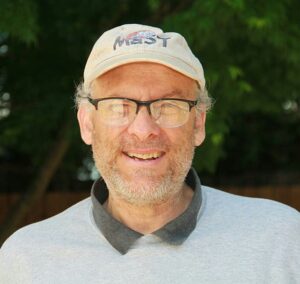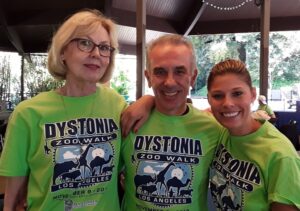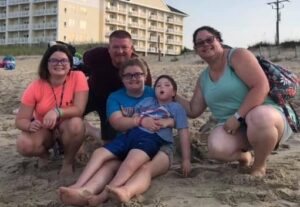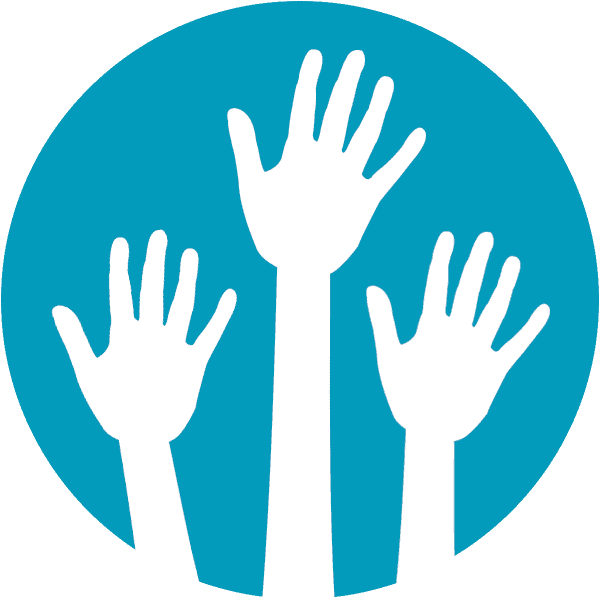Gone Viral: Stories from the Dystonia Community in a Pandemic
This article was originally published in the Dystonia Dialogue.
The Covid-19 outbreak has had a disproportionate impact on individuals with disabilities and chronic medical conditions, including those with dystonia. There has been widespread disruption of local public services, delays in treatment appointments, and changes to everyday routines. The DMRF checked in with several members of the dystonia community to see how they were faring in these unusual times.
Wayne

Wayne Branson resides in Auburn, Washington, not far from the first reported case of Covid-19 in the United States. “All of a sudden we’re sitting in the middle of The Hot Zone,” he recalled, after reports of infections began exploding in March. “It got my attention because I am a cancer survivor and also a dystonic person, and I’m on a pile of pills that can weaken my immune response.” His neurologist was adamant that he stop reporting into work and provided documentation for his employer, an aircraft manufacturing company where he has worked for 13 years.
The day after Wayne took medical leave, he and 95% of the factory staff were laid off. Most of those employed at the company are individuals with disabilities.
Wayne was diagnosed with thyroid cancer in the late 1990s while pursuing a graduate degree in chemistry. He has been cancer free since 1999, defying the prognosis that he would not survive six months. In 2008, he was diagnosed with dystonia, after decades of escalating symptoms. By 2016 it became generalized. “I was having trouble walking,” he recalled, “I couldn’t go up and down stairs. The cramping at night was incredible—my back would arch off the bed.” A combination of oral medications and lifestyle adjustments have kept his symptoms and pain fairly controlled.
“The cancer is gone, except for the fact that it changed my attitude about being alive,” he shared. “Every day is new and fresh and it really helps me with the dystonia because there are good days and there are rough days.”
Wayne is accustomed to self-isolating as a precaution during flu season, but he soon realized Covid-19 created a different situation entirely. Half his income disappeared. No more chatting up clerks in the grocery store or small talk with co-workers. Ventures outside the home are limited to quick trips for essentials. At the end of the work day, he used to stay an extra hour to break up large wooden pallets to fit more compactly in the company’s recycling dumpster. The exercise helped him sleep at night. He stopped volunteering at a nearby aquarium run by a local college. “I’m missing all that interaction with the world. I had some savings. All of these things were vaporized. I’m like everybody else, waiting. And all I can do now is sit at home. There’s nowhere to go.”
Before the pandemic, Wayne rarely had dinner with his three housemates. Now they have dinner multiple times a week, sharing stories and telling jokes. “My online friends suddenly became even more important, and it’s really very different,” he said. He corresponds with friends and family members all over the world, including a cousin in the United Kingdom who is also affected by dystonia.
“I’m glad that I studied things like biochemistry as much as I did because it helps me understand what’s happening with the pandemic,” Wayne said. “I surround myself with positive things, things I enjoy—I really like to find out what are the latest things going on in quantum mechanics. I find YouTube videos of funny, campy, 1950s science fiction stuff. I look for opportunities to encourage other people, because when I encourage someone, I feel encouraged.”
Wayne has kept in touch with his physicians via phone and video conference. His neurologist insists on weekly check-ins via confidential email. One of the things they discussed is adjustments to his medications to address increasing symptoms he has been experiencing due to the added stress of sheltering in place. “I still have access to doctors even though I can’t go anywhere and they can’t see me in the clinic,” he explained. “Something that I really encourage people to do, is reach out how you can. And don’t be afraid to talk to your medical team, especially if you are isolated.”
Janis

“At 71, I kind of appreciated that the world slowed down a little because, even though I live in a suburb of Los Angeles, kind of far out, people zip around and I feel like I’m always trying to keep up.” Janis Eiler is a former security and investigations professional who retired early several years ago due to cervical dystonia. Janis is a past Co-Leader of the Los Angeles Dystonia Support Group.
In May, her neurologist’s office informed her that her botulinum neurotoxin therapy appointment coming up in a few days was canceled. They could offer no estimate for when she might be rescheduled.
“The injections help me a lot,” she explained. “I don’t get real emotional, but I was like, really? I was really counting on this. I had no timeframe whatsoever and that’s hard for me, knowing that I would be declining.”
The delay in treatment immediately brought to mind her condition during an early clinical trial for botulinum neurotoxin. In retrospect, she realized she was given a placebo. This meant she was without treatment for weeks during the study. “I had flashbacks of the pain and headaches,” she said. “The headaches would be really terrible and the muscle pulling, my head would be pulled to one side. At best, I could walk around at work with a clipboard holding my chin up and at home I’d wear a soft collar.”
Even though Janis’ adult children live nearby, social distancing precautions complicate her access to their assistance. “So, the fear was I’m basically all alone. What do I do now?” she thought.
Fortunately, Janis’ injections were rescheduled three weeks after she was due. But the procedure had changed. She had to be tested for the Covid-19 virus 72 hours in advance of the appointment. The Covid testing was a strange experience: “They did the testing through a wall with these arms that look like a space suit with gloves. It was really funny because it came through at a certain height, and I’m about six feet tall, so I had to lean way down for them to do the throat swab and nasal thing. That was basically it. When I went on Monday for my [injections], I knew it would be a big deal and it was.”
On the day of her appointment, she checked in at the main entrance of the medical center. She had to wash her hands, wear a face mask, and answer a litany of questions. This earned her a sticker on her shirt to indicate she was allowed to proceed into the building. When she arrived at the clinic waiting room, she was the only patient there. The nurse who greeted her was covered head to toe in protective medical equipment. Even the manner in which her doctor administered the injections was different: “Normally he will rest a hand on my shoulder and talk to me, and give me the shots, reassure me. But he was all gloved up and suited up—it was just like, here it comes! They kind of hurt.”
Before and since receiving her injections, Janis has been exploring various means to stay as comfortable as possible both physically and mentally while sheltering in place. She is meditating more, exploring gentle stretching exercises she can do from home, and uses aromatherapy to create a calming atmosphere. She adopted a second cat. “Having a pet is nice because they’re affectionate and they’re fun. They keep you running around, doing stuff,” she said.
Her favorite “low tech” wellness solutions are regular walks with her daughter and daily afternoon naps she never previously had time for. “Anxiety makes my condition way worse, makes my headaches way worse, and I tend to cycle downward when I start to think, what if this, and then what if this, and oh no… and that’s when I say, okay, you need to lay down and read a book and fall asleep. That really helps me break that anxiety cycle.”
Kelsey
2020 was going to be a big year for Kelsey. She planned to swim the San Francisco Bay from Alcatraz Island, train for a fall marathon, and travel with her husband. As a DMRF Douglas Kramer Young Advocate Award recipient, she and her mom were planning to travel from Texas to Washington, DC for Dystonia Advocacy Day. She also came to the sobering realization that her dystonia was worsening and she needed deep brain stimulation (DBS).
For four years, Kelsey has worked as a radiation therapist and computed tomography tech in a busy cancer center. She is on her feet all day, has close interaction with patients, and does a lot of heavy lifting. As the country began to shut down due to the pandemic, the cancer center got busier. Several staff members were quarantined due to Covid-19 exposure or sent home for the day with elevated temperatures. Due to personnel shortages, a skeleton crew works 14-hour days that begin at 5:30 am. Staff must often work alone in situations where they would normally work in pairs.
For most of her employment at the center, Kelsey was able to keep her dystonia private. The twitches in her arms and body are not frequent enough for most people to notice. The dystonia causes posturing in her foot, curvature in her spine, and mild symptoms in her hands. In February, several fingers began to noticeably contract inward, affecting her grip. When she shared her situation with supervisors, she was encouraged by the initial response. “They were very understanding at the beginning and then Covid-19 hit and, even though disability isn’t something you can become too busy for, I think my workplace just became too busy to worry about it,” she said. When she expressed concern to senior faculty that she needed assistance to deadlift and transition an immobile 300lb patient, the response was, “You’re resourceful. You’ll figure it out.” When she informed a supervisor that her neurologist recommended DBS and she would need to schedule time off for surgery, the supervisor expressed annoyance that Kelsey’s medical leave might cause a scheduling inconvenience.
“I have absolute confidence that I can take care of my patients,” Kelsey explained, “but I don’t have the confidence that I’m going to be safe or uninjured in the process.”
These days Kelsey comes home from work exhausted. “Sometimes I’ll go home and I’ll just feel defeated, and I think to myself, does everyone else feel this way? I think the best thing that I’ve done is, just have your bad moment, but don’t let your bad day become your bad life,” she said.
For years, fitness has been Kelsey’s outlet for fun, managing stress, and staying in shape. Her favorite activities are rigorous obstacle course races: running, jumping, climbing, swimming. Lately, weight training and other activities have been made more difficult due to the changes in her hands and grip. She and her husband have stayed active during the pandemic by exercising in a park near their home.
As grueling as the past several months have been for Kelsey physically, the emotional aspects have hit especially hard. “Dealing with the physical combined with the mental stress of feeling like people aren’t taking you seriously, or they think that you’re exaggerating, that is what can make people fall down that well of self-pity and depression,” she said.
She credits a supportive spouse and church community for helping her cope. Despite the declining ability in her hands, she finds comfort in playing music. She explained, “I still force myself to sit down at a piano and sing praise and worship and really just allow me a moment to get over myself.”
She expects to have her first surgery of the DBS process this fall. “DBS is my light at the end of the tunnel,” she said.
Aidan & Sunshine

“We tease Aidan that he’s had us in training for a pandemic for years,” joked Sunshine Fox, whose 10-year-old son has dystonia. “We have always been very vigilant with hand-washing and sanitizing, extra precautions to keep him safe.” Sunshine is a Co-Leader of the Central Indiana Dystonia Support Group.
Aidan is diagnosed with a rare neurometabolic disorder that includes dystonia and microcephaly. His mobility, speech, and development are affected. Dystonia affects the core muscles surrounding his diaphragm, reducing his ability to cough; this makes him susceptible to dangerous lung infections. “We constantly keep an eye on those lungs, so when this pandemic started and the virus was affecting the lungs, it was immediately like, oh my gosh, this could affect Aidan so terribly,” said Sunshine.
To complicate matters further, as the virus outbreak escalated, Aidan was in the middle of the deep brain stimulation (DBS) process. The family was commuting from Whiteland, Indiana to a major movement disorder center in Cincinnati for Aidan’s care. He had his first surgery in January, and a second in February. Two weeks after the second surgery, his neurostimulators were turned on at very low settings, with the intention of making adjustments every month. Before they could visit the clinic for another adjustment, everything shut down due to the pandemic.
Sunshine’s husband Darrick began working from home. Aidan and his sisters Kendra (18) and Alissa (15) were home from school. Sunshine continued part-time work at a garden center. The family already employed in-home nurses five days a week and upped their hours to help care for Aidan.
At the height of the country’s transition to sheltering in place and shutting down all but essential businesses in late March, Sunshine paused to wonder what Aidan must be thinking about it all. She made a post to her Facebook page that began: “All is right in Aidan’s world.” She explained: “He was totally unaware of what was going on outside his front door. He was focused on his family’s home. His sisters are home all the time and Dad’s home and his favorite nurses are here. He’s getting spoiled because he doesn’t feel good. I had a moment of stepping away from all my concern that people aren’t taking this virus seriously, all the overwhelming chatter in my head, and I could see that this isn’t so bad for Aidan. He was okay. He was safe.”
As the weeks passed, the botulinum neurotoxin injections that had kept Aidan’s dystonia fairly controlled began to wear off, causing the symptoms to intensify. His stimulator settings could not be adjusted to compensate, because the clinic was not seeing patients due to the shutdown. “The month of April was absolutely miserable for Aidan,” said Sunshine, “We knew it was going to be a rough go for a while. We just weren’t prepared for a pandemic in the middle of it.”
Aidan celebrated his 10th birthday on April 19. The family rallied during the tough weeks to help keep his spirits up and keep him as comfortable as possible. “We work really good as a team,” Sunshine said. “Our girls are so fantastic and their life has been turned upside down by having Aidan as a brother but they haven’t let it make them bitter or upset. He just loves them to pieces and they love him.”
Aidan was able to get back into the clinic for a DBS adjustment in May. He returned to physical therapy in June. Sunshine is grateful for these “baby steps” toward a more familiar routine: “He’s ready to get some normalcy back into his life. It’s been a long haul for him.”
It is unclear what the lasting impact of the pandemic will be for the Fox family. Certain routine, even mundane, facets of life have become weightier. Every Wednesday, after physical therapy, Sunshine and Aidan used to go shopping. “It’s those little moments of, am I ever going to feel comfortable taking him back to Target?” she wondered out loud. “Those mommy and Aidan moments that I kind of took for granted in the past. He doesn’t quite understand, why are we not doing that anymore? It’ll be a long time before I’m comfortable doing some of those little things that we used to do.”
The Dystonia Medical Research Foundation is a 501(c)(3) non-profit organization dedicated to advancing research for improved dystonia treatments and ultimately a cure, promoting awareness, and supporting the well-being of affected individuals and families.



